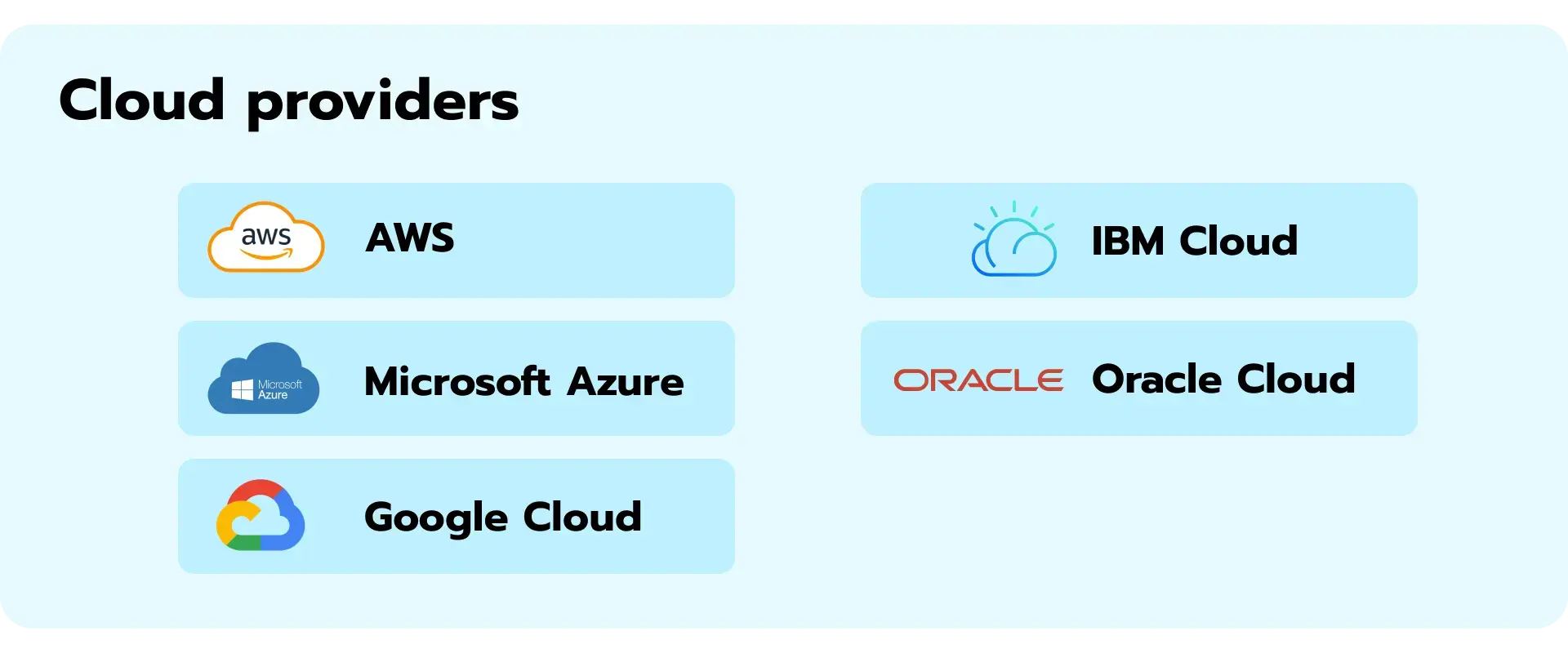AI and cloud computing are certainly a marriage set in heaven, yet matching the right bride with the right groom might be quite a challenge.
The cloud AI market is experiencing an explosive surge. It was worth USD 46.67 billion in 2022 and is expected to reach USD 397.81 billion by 2030. This represents a remarkable annual growth rate of 30.9% from 2023 to 2030.
Several factors are driving this rise of cloud artificial intelligence. One key thing is the increasing adoption of generative AI as well as conventional AI algorithms across industries. Advances in cognitive computing and automation are another. The expansion of 5G networks is expected to boost cloud computing and web traffic further, creating more opportunities for cloud AI.
According to a 2022 Pluralsight report, 75% of tech leaders are now developing new products and features in the cloud, reflecting a strong shift toward cloud-based solutions. This wave of cloud and AI adoption reflects a broader trend toward more powerful and flexible technology solutions. As businesses continue to compete in embracing cutting-edge tech, cloud AI is set to reshape how they operate.
In this article, we will explore the impactful symbiosis between cloud and artificial intelligence and outline the common challenges businesses face when selecting the right cloud provider. But first, we will examine the key drivers behind AI adoption across industries.
How a business can use AI: the most popular AI applications
In this section, we’ll provide a quick rundown of how forward-thinking organizations apply AI. As you’ll see, there are specific areas where the algorithms typically excel.
Enhanced customer experience
Let’s examine some examples of AI’s successful use in increasing client satisfaction.
- Personalized recommendations. Amazon’s recommendation engine, powered by AI, is estimated to drive over 35% of its revenue.
- Improved customer service. AI-powered chatbots can handle a large volume of customer inquiries efficiently. For instance, companies like Zendesk have reported a significant reduction in customer service costs after implementing AI-powered chatbots.
- Sentiment analysis. By understanding customer sentiment, businesses can tailor their offerings accordingly. Companies like Salesforce use AI to analyze customer feedback and improve products and services.
Increased efficiency and productivity
Now let’s highlight how AI helps organizations become more nimble, productive, and efficient operation-wise.
- Automation of tasks. GenAI, a subset of AI, can automate repetitive tasks, freeing up employees for higher-value work. According to McKinsey, By 2030, activities that account for up to 30 percent of hours currently worked across the US economy could be automated.
- Supply chain optimization. AI can optimize inventory levels, improve logistics, and predict demand. Companies like Walmart use AI to forecast demand and optimize their supply chain, resulting in significant cost savings.
- Predictive maintenance. AI can help prevent costly downtime by predicting equipment failures. Many renowned companies in manufacturing and transportation report significant reductions in maintenance costs through AI-powered predictive maintenance.
Data-driven decision making
The right AI model can also help prevent fraud and provide important insights for high-level strategic decision-making.
- Fraud detection. Financial institutions use AI to detect fraudulent transactions, saving billions of dollars annually.
- Risk assessment. Insurance companies use AI to assess risk and price policies accurately.
- Market analysis. AI can analyze vast amounts of market data to identify trends and opportunities. Companies like Netflix use AI to analyze viewer preferences and create successful content.
Innovation and new business models
AI is gradually becoming a valuable part of organizations’ innovative projects, powering new types of business models.
- Drug discovery. AI is accelerating drug discovery by analyzing vast amounts of data to identify potential drug candidates. Companies like Atomwise are using AI to develop new treatments for diseases. An in-depth research on how GenAI specifically is being utilized in pharma and life sciences can be found here.
- Autonomous vehicles. Self-driving cars powered by AI have the potential to revolutionize transportation. Companies like Tesla and Waymo are leading the way in this field.
- Virtual assistants. AI-powered virtual assistants like Siri, Alexa, and Google Assistant are becoming increasingly sophisticated, opening up new opportunities for businesses.
Financial performance
Finally, when applied to suitable use cases, AI has been effectively used to increase revenue and overall profitability.
- Increased revenue. AI can help businesses increase revenue through improved customer experience, new product development, and optimized pricing.
- Cost reduction. Automation of tasks, optimized operations, and reduced errors can lead to significant cost savings.
- Improved profitability. By combining increased revenue and reduced costs, AI can significantly improve a company’s profitability.
| Benefits |
Applications |
Examples |
| Enhanced customer experience |
Personalized recommendations, improved customer service, sentiment analysis |
Amazon, Zendesk, Salesforce |
| Increased efficiency and productivity |
Automation of tasks, supply chain optimization, predictive maintenance |
Mckinsey, Walmart |
| Data-driven decision making |
Fraud detection, risk assessment, market analysis |
Most large financial institutions, insurance companies |
| Innovation and new business models |
Drug discovery, autonomous vehicles, virtual assistants |
Atomwise, tesla, waymo |
Figure 1. AI uses (examples and benefits)
As you can see, AI is relatively industry-agnostic and can be applied to both customer-facing and internal processes. However, there’s a caveat. It can only work for a limited number of use cases, which businesses must meticulously select. The other thing is that the algorithms are extremely resource-hungry, which means that, up until the cloud came along and became widely available, only a handful of giants across a few industries could make AI work efficiently.
Learn how we boosted customer engagement with advanced chat functionality for Clickatell. Success story.
What are the benefits of the cloud, and why do cloud and artificial intelligence match so perfectly?
There are many reasons businesses choose to deploy AI in the cloud, mostly related to the cloud’s resourcefulness, scalability, and ease of use. Let’s review the main advantages so you get the overall picture.
Combining scalability and agility
- Elastic compute power. Tailoring infrastructure to the precise demands of different AI workloads by leveraging a variety of computing resources, such as CPUs, GPUs, TPUs, and specialized accelerators. This can have massive benefits for optimizing both cost and performance.
- Infrastructure as code (IaC). Implementation of rapid, repeatable, and version-controlled deployments by treating infrastructure as code. This is crucial for AI experimentation, where infrastructure needs to evolve alongside model development.
- Serverless computing. Eliminating the need for provisioning and managing servers by using serverless computing for AI workloads with intermittent or unpredictable traffic patterns. Again, this can have massive implications for optimizing costs and enhancing developer productivity.
Democratizing AI
- Pay-per-use model. Enabling organizations of all sizes to access and leverage AI by utilizing the cloud’s consumption-based pricing. This allows businesses with modest resources to experiment with the power of AI without hefty upfront investments.
- Specialized hardware access. Accessing specialized hardware, such as GPUs and TPUs, through cloud providers at a fraction of the cost of on-premises procurement. This levels the playing field for organizations seeking to train complex models.
- Open-source integration. Seamlessly integrating with open-source AI frameworks and tools, fostering a vibrant ecosystem of innovation and reducing development costs.
Accelerating innovation through collaboration and knowledge sharing
- Data lakes and warehouses. Providing a centralized location for storing and managing vast datasets through cloud-based data repositories. Enabling data scientists to collaborate effectively and derive valuable insights.
- MLOps platforms. Streamlining the AI lifecycle, from data ingestion and model training to deployment and monitoring through integrated MLOps platforms. Accelerating experimentation, improving model quality, and ensuring operational efficiency.
- AI-powered development tools. Enhancing developer productivity and accelerating time-to-market through cloud-based IDEs and development environments offering AI-assisted coding, debugging, and testing capabilities.
Risk mitigation and compliance
- Robust security infrastructure. Protecting sensitive data and ensuring compliance with industry regulations through advanced threat detection, prevention, and response mechanisms employed by cloud providers.
- Disaster recovery and business continuity. Minimizing downtime and protecting critical AI applications through built-in redundancy and failover capabilities provided by cloud-based infrastructure.
- Compliance frameworks. Simplifying adherence to regulatory requirements through compliance certifications (e.g., HIPAA, GDPR, SOC 2) offered by many cloud providers.
Driving business value through data-driven insights
- Advanced analytics and machine learning. Empowering businesses to extract actionable insights through a rich suite of tools provided by cloud platforms for data exploration, visualization, and predictive modeling.
- Integration with business applications. Improving decision-making and operational efficiency by seamlessly integrating AI-driven insights with enterprise systems and embedding them into business processes.
- AI-driven automation. Automating repetitive tasks through cloud-based automation platforms. Freeing up human resources to focus on higher-value activities and driving cost savings.
While these benefits are desirable, realizing them is not straightforward. Although the cloud can help overcome some of the challenges associated with procuring AI resources, selecting the optimal provider for your specific business needs is complex. And as our experience has repeatedly shown, choosing the right platform can significantly impact the success of your AI project.
So, why is it so hard to choose the right cloud AI services?
Again, the reasons are multifold. Here are just some of the factors that contribute to this selection complexity:
Too many cloud providers and offerings
There are numerous cloud providers, each offering a range of AI services and infrastructure options. Major players like Amazon Web Services (AWS), Microsoft Azure, Google Cloud Platform (GCP), and IBM Cloud have extensive portfolios of AI tools, including machine learning frameworks, data storage, and processing capabilities. The differences in service offerings, pricing models, and specialized tools create a challenge for those trying to identify the best fit for their specific needs. Figure 2. Leading cloud providers.
Figure 2. Leading cloud providers.
A wide variety of AI workloads
AI workloads vary widely depending on the use case. Some businesses, typically larger ones, may need cloud services optimized for deep learning, while others might require robust data processing capabilities or real-time analytics. The cloud provider’s ability to support all those needs—ranging from training large models to deploying real-time inference systems—defines its appeal. However, not all clouds are equally adept at handling every type of AI workload, which sometimes makes the choice of provider challenging.
Integration with existing systems
Companies often have existing IT infrastructure, databases, business intelligence, and software systems that must seamlessly integrate with the cloud provider’s AI services. This integration can be complex, especially if the company uses proprietary systems or multiple cloud environments (multi-cloud strategy). Evaluating whether a certain cloud possesses the needed integration capabilities with these systems without causing disruptions or requiring extensive re-engineering is a significant consideration that many organizations might find hard to tackle.
Data security and compliance
AI systems often handle sensitive data, requiring robust security measures and compliance with regulations such as GDPR, HIPAA, or CCPA. Different cloud providers offer varying levels of security features and compliance certifications. Companies must carefully assess all cloud security aspects to ensure that their AI workloads are secure and meet all regulatory requirements. This is particularly challenging when operating in highly regulated industries like healthcare, finance, or government sectors.
Cost management
AI workloads can be resource-intensive, as we’ve mentioned, requiring significant computational power, storage, and data transfer capabilities. Cloud providers typically offer different pricing models, including pay-as-you-go, reserved instances, and spot pricing. The challenge lies in predicting and managing costs effectively, especially when scaling AI applications. Misjudging the cloud provider’s pricing structure can lead to unexpectedly high costs, making cost optimization a critical factor in the decision-making process.
Scalability and performance
AI projects often start small but can scale rapidly as models are refined and deployed into production. The chosen cloud provider must support both the initial development phase and subsequent scaling efforts without compromising performance. So, when picking a provider, companies must look into their global infrastructure, data center locations, network latency, and availability of high-performance computing resources. Businesses must ensure that their AI workloads will perform optimally at scale, which is a complex evaluation process.
Vendor lock-in concerns
Selecting a cloud provider can lead to vendor lock-in, where a company becomes dependent on a single provider’s services and technologies. This can limit flexibility and make it difficult to switch providers or adopt a multi-cloud strategy in the future. Companies need to carefully consider the potential for vendor lock-in and explore strategies to mitigate it, such as ensuring the portability of their AI workloads across different cloud environments.
Evolving technology landscape
The field of AI is rapidly evolving, with new frameworks, tools, and technologies emerging regularly. Cloud providers continuously update their offerings to incorporate the latest advancements. However, keeping pace with these changes and understanding how they align with a company’s AI strategy is hard, especially for businesses that are not inherently tech-oriented. Companies need to choose a cloud provider that not only meets their current needs but is also likely to support future AI developments.
Expertise and support
Implementing AI solutions in the cloud requires specialized expertise. Companies may face difficulties if they lack the necessary skills or experience to manage and optimize AI workloads in a specific cloud environment, and this is essential for fully capitalizing on AI capabilities. The availability of training, documentation, and support services from the cloud provider is crucial in overcoming these challenges. Companies must assess the level of support and resources offered by the cloud provider to ensure the successful deployment and operation of AI projects.
Performance and accuracy
Other critical factors we must consider when choosing the right cloud for AI workloads are performance and accuracy. Each provider has their own level of expertise and optimization in specific AI domains, so it’s crucial to assess these specific capabilities meticulously. For instance, document AI tasks require evaluating performance across different document types (digital, scanned, or photographed), document formats (e.g., DOC, Excel, PDF), and language support. Additionally, we should verify their ability to handle varying document volumes and complexities without compromising accuracy. Understanding the provider’s performance metrics, benchmarks, and error rates for particular AI tasks is essential to ensure that the chosen service aligns with the desired level of quality and reliability.
Strategic alignment
Finally, choosing the right cloud provider for AI needs involves aligning the decision with the company’s overall strategic goals. This includes considering factors such as long-term AI strategy, innovation goals, and competitive positioning. The cloud provider should not only meet technical requirements but also align with the company’s vision for the future of AI within its industry.
| Overwhelming options |
Navigating numerous cloud providers and their diverse offerings. |
| Workload diversity |
Handling various AI workloads, from deep learning to real-time analytics. |
| Integration complexity |
Integrating with existing IT systems and avoiding disruptions. |
| Data Security and compliance |
Protecting sensitive data and adhering to regulations. |
| Cost management |
Predicting and controlling costs due to resource-intensive workloads. |
| Scalability and performance |
Ensuring optimal performance as AI projects grow. |
| Vendor lock-in |
Avoiding dependence on a single cloud provider. |
| Evolving technology |
Keeping pace with rapid AI advancements. |
| Expertise and support |
Accessing necessary skills and resources for AI implementation. |
| Performance and accuracy |
Achieving desired levels of performance and accuracy for specific AI tasks. |
| Strategic alignment |
Matching cloud provider’s offerings with company’s long-term AI goals. |
Figure 3. Key challenges related to picking a cloud provider.
Summing up
In conclusion, the rapid expansion of the cloud AI market and the intricate challenges of selecting the right cloud provider underscore the critical need for careful planning and strategic decision-making. To fully realize the potential of AI, effectively combining cloud computing and AI is becoming essential. However, the multitude of factors—ranging from workload requirements and integration capabilities to cost management and vendor lock-in—makes provider selection complex and often overwhelming.
Recognizing these challenges, Avenga has developed a specialized platform called Cloud Companion to simplify the process. By analyzing your company’s specific requirements, the tool automatically estimates and recommends the cloud provider that best aligns with your AI needs. Use this innovative tool today not only to save time and resources but also to confidently launch your AI project, knowing you have the optimal cloud infrastructure in place to support your goals.


 Figure 2. Leading cloud providers.
Figure 2. Leading cloud providers.






